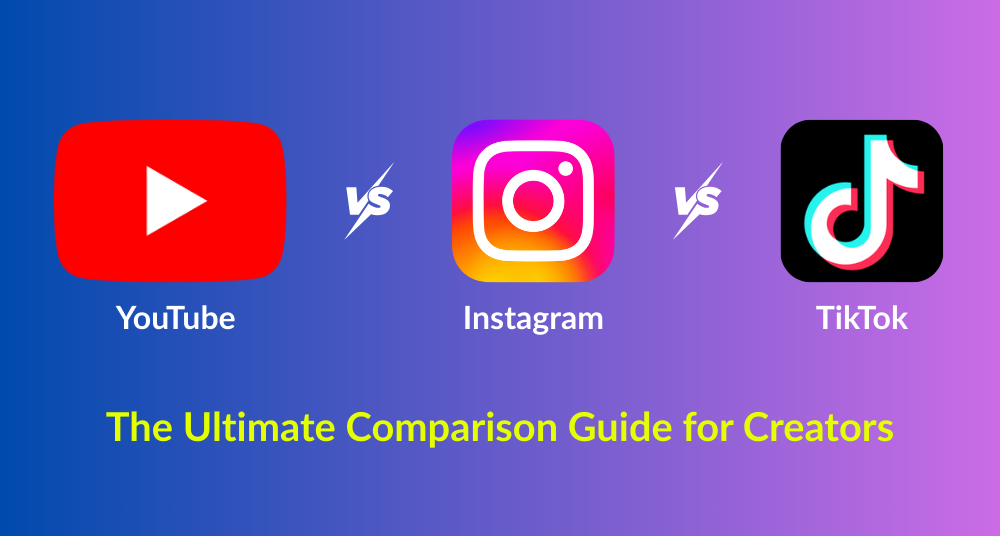The rise of social media has transformed how we communicate, consume content, and even conduct business. In 2025, platforms like YouTube, Instagram, and TikTok are not just social networks—they are powerful ecosystems for creators, marketers, and businesses to reach millions globally. Video content, in particular, has become the dominant form of online engagement, with users spending hours daily watching, sharing, and interacting with video content across platforms.
For content creators, these platforms provide opportunities to showcase creativity, build a loyal audience, and earn revenue through multiple channels. For marketers, understanding which platform to prioritize can directly impact brand visibility, engagement, and sales. However, each platform caters to a different audience, follows a distinct algorithm, and offers unique tools and monetization strategies.
This guide will compare YouTube, Instagram, and TikTok in depth, examining audience demographics, content strategies, algorithm mechanics, monetization options, marketing potential, and future trends. By the end, creators and marketers will have a clear understanding of which platform aligns with their goals, how to maximize growth, and how to implement a multi-platform strategy effectively.
YouTube: The King of Long-Form Content
Overview
Launched in 2005, YouTube is the largest video-sharing platform globally, with over 2.7 billion monthly active users. It supports videos of all lengths, including tutorials, vlogs, educational content, webinars, reviews, and entertainment. YouTube’s focus on long-form content makes it ideal for creators who want to build credibility and authority in their niche.
Audience Demographics
- Age Group: 18–49 years (highest engagement in 25–34 years)
- Gender: Roughly equal male-female distribution
- Geography: Global audience, strong presence in the US, India, Europe, and South America
- Interests: Education, entertainment, lifestyle, technology, gaming, fitness
Algorithm & Growth Factors
YouTube’s algorithm prioritizes:
- Watch time: Longer engagement boosts content visibility.
- Click-through rate (CTR): Optimized thumbnails and titles improve clicks.
- Consistency: Frequent uploads increase channel growth.
- Engagement: Comments, likes, shares, and subscriptions signal relevance.
- SEO optimization: Google search integration makes discoverability easier.
Content Types That Perform Best
- Tutorials and How-To Videos: Step-by-step guides in tech, cooking, or education.
- Vlogs: Personal experiences, travel, or lifestyle content.
- Reviews and Product Demos: Tech, beauty, and service reviews.
- Educational Content: Language, coding, marketing, and professional development.
- Live Streams: Real-time audience interaction for Q&A, webinars, and events.
Monetization Opportunities
- YouTube Partner Program: Ad revenue from video views.
- Channel Memberships: Subscription-based perks for fans.
- Super Chat & Super Stickers: Monetization during live streams.
- Brand Sponsorships: Paid promotions integrated into content.
- Affiliate Marketing: Earning through product recommendations.
Pros
- High credibility and authority
- Strong SEO and long-term discoverability
- Multiple monetization streams
- Suitable for serious creators aiming for sustainable growth
Cons
- Highly competitive, requiring consistency
- High production effort (scripting, editing, graphics)
- Slow initial growth without optimization
Case Study
MrBeast, one of the fastest-growing creators, leveraged long-form content, consistent uploads, and viral challenge videos to reach over 400 million subscribers, generating millions in ad revenue and brand deals.
Instagram: Visual Branding & Engagement
Overview
Instagram focuses on images, reels, stories, and short-form videos. With over 2 billion active users, it has become the go-to platform for influencers, brands, and lifestyle creators. Its visually-driven interface makes it perfect for storytelling, branding, and e-commerce integration.
Audience Demographics
- Age Group: 18–34 years (millennials & Gen Z dominate)
- Gender: Slightly female-skewed audience
- Interests: Fashion, beauty, travel, fitness, food, lifestyle, tech
- Engagement: Mobile-first platform with high interaction via likes, comments, and shares
Algorithm & Growth Factors
Instagram’s algorithm is primarily engagement-based, considering:
- Interest: Shows content relevant to user behavior.
- Recency: Newer posts are prioritized.
- Relationship: Content from accounts users frequently interact with is ranked higher.
- Content type preference: Reels, Stories, and Carousel posts are favored depending on user habits.
Content Types That Perform Best
- Reels: Short, engaging videos ideal for virality.
- Stories: Interactive polls, quizzes, and behind-the-scenes content.
- Carousel Posts: Multiple images for storytelling and education.
- IGTV: Long-form videos for tutorials and interviews.
Monetization Opportunities
- Sponsored posts and brand partnerships
- Affiliate marketing and product placements
- Instagram Shop and direct e-commerce sales
- Paid collaborations for micro and macro influencers
Pros
- High engagement with short-form visual content
- Great for brand partnerships and influencer marketing
- Shopping integration enables direct sales
- Viral potential through Reels and trending hashtags
Cons
- Limited organic reach due to algorithm changes
- Requires frequent posting for visibility
- Less suitable for detailed long-form content
Case Study
Kylie Jenner uses Instagram for lifestyle branding, product promotions, and direct sales via Instagram Shop, generating millions in revenue annually while maintaining high engagement.
TikTok: Short-Form Video & Virality
Overview
TikTok focuses on short, entertaining videos ranging from 15 seconds to 3 minutes. Since its global explosion in 2018, it has attracted over 1 billion monthly active users and become a trendsetter for Gen Z creators.
Audience Demographics
- Age Group: 16–24 years (Gen Z dominates)
- Gender: Balanced, slightly younger-skewed
- Content Preferences: Trends, memes, dance, comedy, tutorials
- Engagement: Very high due to algorithmic recommendations and interactive content
Algorithm & Growth Factors
TikTok’s For You Page (FYP) algorithm promotes content based on:
- User interactions (likes, shares, watch duration)
- Video information (hashtags, captions, sounds)
- Device and account settings
- Content trends (challenges and viral sounds)
Content Types That Perform Best
- Short, catchy entertainment videos
- Viral challenges, dance, and lip-sync content
- Memes and trend-based content
- Tutorials condensed into 30–60 seconds
Monetization Opportunities
- TikTok Creator Fund
- Brand sponsorships
- Affiliate marketing
- Live gifting from followers
Pros
- Rapid growth and virality potential
- Easy content creation with in-app editing tools
- High engagement among younger audiences
Cons
- Short content lifespan
- Limited long-form storytelling
- Monetization less stable than YouTube
Case Study
Charli D’Amelio rose to fame by posting short dance videos on TikTok, gaining over 150 million followers, landing sponsorships, and becoming one of the highest-paid TikTok creators.
Cross-Platform Comparison
| Feature | YouTube | TikTok | |
| Content Type | Long-form, tutorials, live | Short-form, reels, stories | Short-form, trends, challenges |
| Monthly Users | 2.5B+ | 2B+ | 1B+ |
| Engagement | Moderate to High | High | Very High |
| Age Group | 18–49 | 18–34 | 16–24 |
| Monetization | Ads, sponsorships, membership | Brand deals, Shop, affiliate | Creator Fund, sponsorships |
| Growth Potential | Slow & steady | Moderate | Fast & viral |
| Best For | Tutorials, vlogs, education | Lifestyle, influencer, branding | Trends, entertainment, virality |
Key Takeaways
- YouTube is best for long-term growth, credibility, and monetization.
- Instagram excels at brand building, visual engagement, and influencer marketing.
- TikTok is ideal for fast growth, trend-based content, and short-form virality.
Strategies for Content Creators & Marketers
YouTube
- Post consistently (2–3 times per week minimum)
- Optimize SEO: titles, tags, and descriptions
- Engage audience via comments and community posts
- Collaborate with other creators
- Use Reels & Stories frequently for higher reach
- Engage through polls, quizzes, and DMs
- Use niche-specific hashtags
- Collaborate with brands and influencers
TikTok
- Follow trending hashtags, sounds, and challenges
- Keep videos short, entertaining, and engaging
- Post daily to maintain visibility
- Collaborate with other TikTok creators for exposure
Cross-Platform Tips
- Repurpose content: turn YouTube tutorials into Instagram snippets or TikTok shorts
- Use analytics to track engagement and optimize posting schedule
- Maintain brand consistency across platforms
Future Trends
AI-Driven Content Creation: Tools to automate video editing, thumbnail design, captions
- AR/VR Integration: Immersive content experiences for engagement
- Short-Form Video Dominance: Reels and TikTok-style videos will continue to grow
- Monetization Innovations: New revenue streams on all platforms
- Cross-Platform Marketing: Multi-platform campaigns for maximum impact
FAQ’S
Q1: Which platform is best for beginners?
- TikTok offers the fastest growth for short, simple, and engaging content, making it ideal for beginners.
Q2: Can I monetize on Instagram?
- Yes! You can earn through sponsorships, affiliate marketing, Instagram Shop, and brand collaborations.
Q3: How often should I post on each platform?
- YouTube: 2–3 times/week, Instagram: daily stories/reels, TikTok: 1–3 videos/day for best engagement.
Q4: Can I grow on multiple platforms simultaneously?
- Absolutely! Repurpose content, optimize it for each platform, and maintain consistent branding.
Q5: Which platform has the highest engagement rate?
- TikTok generally has the highest engagement for short-form content, followed by Instagram Reels, while YouTube engagement depends on watch time and comments.
Q6: Is long-form content better than short-form content?
- Both are valuable. YouTube is ideal for long-form content, while Instagram and TikTok focus on short, viral content to capture attention quickly.
Q7: What type of content performs best on YouTube?
- Tutorials, vlogs, educational videos, reviews, product demos, and live streams perform best for authority and long-term growth.
Q8: Can businesses use TikTok for marketing?
- Yes! Brands can leverage TikTok trends, challenges, and influencer collaborations to reach Gen Z and drive awareness.
Q9: Do hashtags help growth on these platforms?
- Yes. Hashtags improve discoverability on Instagram and TikTok, while keywords and tags are essential for YouTube SEO.
Q10: How do I choose the right platform for my niche?
- Consider your target audience, content type, and growth goals. Use YouTube for tutorials, Instagram for branding, and TikTok for viral entertainment or trends.
Conclusion
In 2025, YouTube, Instagram, and TikTok are essential platforms for content creators and marketers. YouTube is ideal for long-form tutorials and monetization, Instagram is best for visual branding and influencer engagement, and TikTok provides rapid virality for trend-based content.
The most successful creators adopt a multi-platform strategy, leveraging YouTube for authority, Instagram for engagement, and TikTok for reach. Understanding audience demographics, algorithm behavior, content type, and monetization options is key to growing effectively.
Consistency, quality content, and strategic posting are non-negotiable. By mastering these platforms, creators and marketers can build massive followings, monetize content, and influence audiences globally.
The future belongs to creators who understand each platform deeply and innovate continuously. Start today, stay consistent, and leverage each platform’s strengths to maximize growth and revenue.
Related Blog: 15 Best YouTube Tools






What do you think?
It is nice to know your opinion. Leave a comment.